Overview – Memory
Memory is the ability of the mind to retain information. The A Level psychology syllabus looks at various cognitive models of memory, starting with the multi-store model (MSM), which breaks memory down into 3 components:
- Sensory register
- Short-term memory
- Long-term memory
Additional cognitive models break down the components of the MSM into further detail. For example, the working memory model (WMM) provides extra detail about how short-term memory works. The syllabus also requires you to know about the different types of long-term memory.
As well as these models of memory, the syllabus also mentions explanations of forgetting, and eyewitness testimony.
Multi-store model
Atkinson and Shiffrin (1968) devised the multi-store model (MSM) of memory. It is a cognitive approach that explains memory as information passing through a series of 3 storage systems: the sensory register, then short-term memory, and then long-term memory.

Each of these storage systems has different features in terms of:
- Coding: The format the information is stored as.
- Capacity: How much information can be stored.
- Duration: How long the information is stored for.
MSM storage systems
Sensory register
The first system of the MSM is the sensory register. It basically contains the immediate data that comes from the senses.
- Information enters the sensory register coded in a raw and unfiltered format via sense organs such as the eyes and ears. This information is processed by dedicated stores – for example, visual information goes to the iconic store, whereas auditory information (sound) goes to the echoic store.
- There is a lot of constantly changing information that passes through these stores, and so the sensory register has a very large capacity.
- However, most information that passes the sensory register is very quickly forgotten, and so its duration is very short. Different sensory stores have different storage duration – for example, the iconic store retains visual data for around 500 milliseconds, whereas the auditory store can retain sounds for up to 2 seconds.
If the individual pays attention to the information coming in via the sensory register, that information is passed on to the next storage system of the MSM – short-term memory – where it may be retained for longer.
Short-term memory
The second system of the MSM is short-term memory (also called working memory within the WMM). It basically contains all the information that an individual is currently thinking about.
- Select information (i.e. information that the individual pays attention to) is passed on from the sensory register in the same raw format. This information is then coded into a format that is more digestible for short-term memory. For example, the words ‘ice cream’ could be coded visually (e.g. imagining a picture of ice cream), acoustically (e.g. repeating the words ‘ice cream’), or semantically (e.g. thinking about the meaning of the words ‘ice cream’ as a sweet and cold dessert).
- Research suggests short-term memory has a capacity for between 5 and 9 (7 ± 2) items. For example, Jacobs (1887) tested participants’ ability to remember strings of letters and numbers. On average, the participants could remember 7 letters before reaching capacity and 9 numbers. However, capacity can be increased by ‘chunking’ items into semantically similar groups. For example, the alphanumeric sequence 193913CIAAQA contains 12 individual items (too many for short-term memory), but these items can be split into 4 chunks (e.g. 1939 = start of World War 2, 13 = unlucky, CIA = Central Intelligence Agency, AQA = the exam board) that are easier to retain.
- The duration of short-term memory is about 30 seconds. This can be extended, though, via rehearsal (i.e. repetition). For example, you might retain a shopping list in your short-term memory by repeating the various items out loud or in your mind.
Extended rehearsal can transfer information from short-term memory to the next storage system of the MSM: long-term memory.
Long-term memory
Long-term memory lasts anywhere from more than 30 seconds to an entire lifetime. There are several different types of long-term memory (see below), but all long-term memories will have originally passed through both the sensory register and short-term memory.
- Like short-term memory, long-term memory can be coded in many ways: visually, acoustically, olfactorily (smell), semantically, and so on.
- Research suggests the capacity of long-term memory is very large, and no studies have been able to determine a limit to the number of long-term memories that can be stored. Although memories are often forgotten, this isn’t because the person has ran out of space for memories but is instead due to deterioration or interference.
- The duration of long-term memory depends on how it is coded and what kind of memory it is (e.g. skills typically have longer duration than facts) but potentially lasts for a lifetime. For example, Bahrick et al (1975) found participants who were shown photos of ex-schoolfriends 48 years after leaving school could still remember 70% of the faces and 80% of the names.
Once a long-term memory is stored, it can be retrieved and temporarily transferred to short term memory and manipulated (this retrieval process may also improve the duration of the memory). An example of retrieval would be remembering a pleasant experience from your childhood and thinking about how you felt that day.
AO3 evaluation points: Multi-store model
Strengths of the multi-store model:
- Evidence supporting the multi-store model: Multiple case studies and analyses support the existence of separate memory stores for sensory register, short-term memory, and long-term memory. For example, in cases of amnesia, individuals tend to either be unable to store short-term memories (anterograde amnesia) or long-term memories (retrograde amnesia), but not both. The existence of these separate stores is further supported by an independent groups experiment by Glanzer and Cunitz (1966). Both groups were shown the same list of words but one group recalled the words immediately after and the other group recalled them 30 seconds later (during which they had to count backwards to prevent rehearsal). Participants in the second group recalled fewer words, supporting the existence of short-term memory with a duration of 30 seconds.
- As the first cognitive explanation of memory, the multi-store model has been highly influential. Subsequent research has drawn on and refined this model to better explain and understand memory.
Weaknesses of the multi-store model:
- Overly simplistic: Both short-term and long-term memory are more complex than the multi store model suggests. For example, the working memory model shows how short-term memory consists of many different components rather than just a single store. Similarly, there are many different types of long-term memory (e.g. semantic and procedural) that are stored and processed in completely different ways.
Working memory model
The working memory model (WMM) was developed by Baddeley and Hitch (1974) and builds on the multi-store model – in particular, the MSM’s model of short-term memory. Rather than replacing the MSM, the WMM is better understood as a more detailed description of the MSM’s short-term memory component.
Whereas the MSM describes short-term memory as a single store, the WMM divides short-term memory into 4 separate components: the central executive, phonological loop, visuo-spatial sketchpad, and the episodic buffer. These components serve different functions and hold different types of information, which are actively worked upon as the individual thinks.
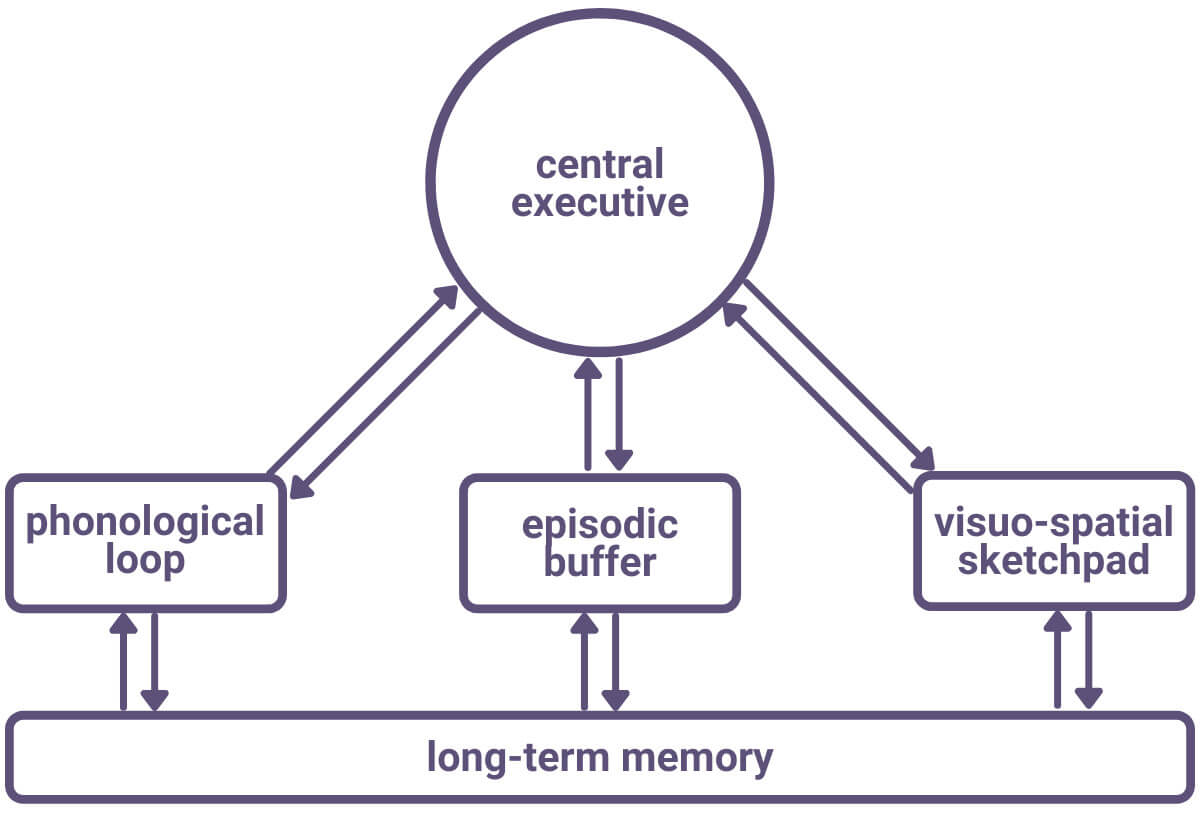
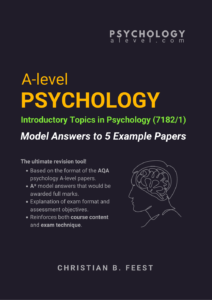 Ryan was able to hold a conversation with a friend whilst driving his car. However, when reading a newspaper later that day, Ryan had to stop what he was doing in order to have a conversation with his friend.
Ryan was able to hold a conversation with a friend whilst driving his car. However, when reading a newspaper later that day, Ryan had to stop what he was doing in order to have a conversation with his friend.
With reference to the working memory model, explain Ryan’s different experiences. [4 marks]
WMM components
Central executive
The central executive is the component that filters and co-ordinates the various components of working memory. It process sensory information coded in all forms (auditory, visual, etc.) and directs this information to three slave systems: the phonological loop, the visuo-spatial sketchpad, and the episodic buffer. The central executive also receives information from these slave systems once it has been processed by them.
The central executive has a fairly limited capacity. For example, Baddeley (1996) observed that participants struggled to perform two tasks (e.g. generating lists of random numbers and switching between pressing letters and numbers on a keyboard) simultaneously, and suggested this was because both tasks were competing for central executive resources.
So, part of the role of the central executive is to co-ordinate its limited capacity. For example, the central executive may direct information required for driving to the visuo-spatial sketchpad, and information required for talking would be directed to the phonological loop – allowing a person to drive and talk simultaneously. The central executive is also responsible for switching attention to specific information sources that require attention.
Phonological loop
The phonological loop is the system that deals with information coded in auditory (sound – particularly words) format. It has two sub-systems:
- Phonological store: A short-term store that briefly retains words and the order they appeared in (sometimes called the inner ear)
- Articulatory loop: Repeats (rehearses) words to keep them within the phonological loop (sometimes called the inner voice)
Research suggests the capacity of the phonological loop is limited to how long words are rather than how many words there are. For example, one long word (e.g. floccinaucinihilipification) is more difficult to store in the phonological loop than three short words (e.g. cat, boat, and happy).
Visuo-spatial sketchpad
The visuo-spatial sketchpad is the mind’s inner eye – it stores visual and spatial information. Information within the visuo-spatial sketchpad is coded as mental pictures.
Episodic buffer
The episodic buffer is a temporary store for information coded in all forms (auditory, visual, etc.).
The original WMM did not include the episodic buffer. But because the central executive has no storage capacity, and the phonological loop and visuo-spatial sketchpad are only able to store and process specific types of information, the introduction of the episodic buffer in 2000 explains how people can combine and store general information from the various components of short- and long-term memory.
For example, the working memory of a story will likely contain visual, semantic, and chronological information (i.e. the order of events). These different types of information would be combined in the episodic buffer to form a coherent story in short-term memory.
AO3 evaluation points: Working memory model
Strengths of the working memory model:
- More accurate and detailed: Whereas the multi-store model explains short-term memory as a single unit, the working memory model accounts for the many different types of short-term memory (e.g. words vs visual information) and the different ways they are processed.
- Evidence supporting the working memory model: Multiple studies support the existence of the separate components of the working memory model. For example, Penney (1975) observed that short-term recall of words is far better when learned verbally (i.e. using the phonological loop) vs. visually (i.e. using the visuo-spatial sketchpad). Elsewhere, brain scans conducted by Smith and Jonides (1997) show increased activity in the left hemisphere when doing verbal tasks whereas spatial tasks resulted in increased activity in the right hemisphere.
Weaknesses of the working memory model:
- Overly simplistic: Despite being more accurate and detailed than the multi-store model, short-term memory may still be more complex than the working memory model suggests. For example, Logie (1995) suggests the visuo-spatial sketchpad should be further divided into visual cache (for storing visual information, e.g. colour) and inner scribe (for storing spatial information, e.g. the location of objects relative to each other). This distinction within the visuo-spatial sketchpad is supported by the Smith and Jonides (1997) brain scans, which show activity in different areas of the brain corresponding to each type of information. Similarly, research suggests the central executive also consists of multiple parts. For example, Miyake et al (2000) found that different people have greater or lesser capacity for certain executive tasks over others, and that some executive tasks are impaired by brain damage but not others. This suggests the central executive consists of multiple different parts rather than a single ‘central’ component.
Types of long-term memory
The multi-store model of long-term memory (LTM) explains it as one single store. However, this is overly simplistic, as research suggests there are many different types of long-term memory.
The main distinction is between explicit and implicit long-term memory. Explicit LTM is conscious and easy to put into words – for example remembering your first day at school (episodic), or a fact such as “Paris is the capital of France” (semantic). In contrast, implicit LTM is more subconscious and includes skills and abilities such as knowing how to ride a bike (procedural).
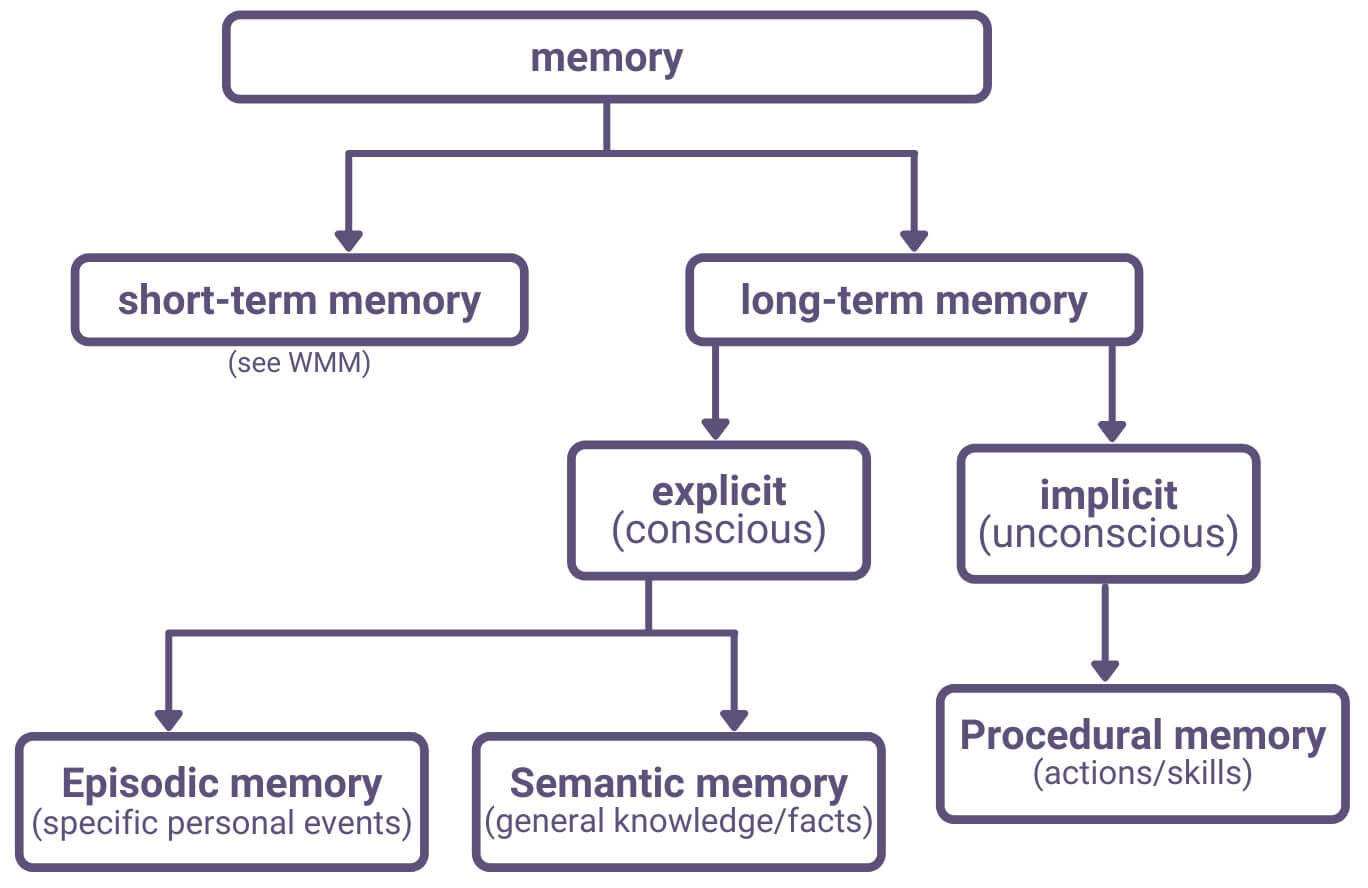
Episodic
Episodic long-term memory covers the story of our lives – things like memories of specific events and the order they occurred in. For example, remembering your first day at school, or a holiday you went on a few years back, or some embarrassing memory of falling over are all examples of episodic long-term memory. It includes context (e.g. time and place), details of what happened, and the emotions felt.
Strong emotions (positive or negative) cause episodic memories to be coded more strongly. Similarly, if episodic memories are highly processed (for example by rehearsal/repetition) they will be coded more strongly.
Semantic
Semantic long-term memory covers meaning, understanding, and general knowledge. Examples of semantic memory would be facts like “the Battle of Hastings was in 1066” and general understanding of concepts like dogs as 4-legged mammals that run around and bark.
Procedural
 Procedural long-term memory covers how to do things – actions, skills, abilities, etc. For example, remembering how to juggle, ride a bicycle, or drive a car. We begin forming procedural memories from a young age – things like knowing how to walk and talk are learned and then stored as procedural memory.
Procedural long-term memory covers how to do things – actions, skills, abilities, etc. For example, remembering how to juggle, ride a bicycle, or drive a car. We begin forming procedural memories from a young age – things like knowing how to walk and talk are learned and then stored as procedural memory.
Although procedural memories are easy to act out, they are difficult/impossible to consciously explain in words. So, unlike semantic and episodic LTM, procedural memory is implicit. The fact that procedural memories do not require conscious thought means they can be recalled while simultaneously performing other cognitive activities – for example, trying to remember what the tallest mountain is (semantic, explicit) while walking along the road (procedural, implicit).
AO3 evaluation points: Long-term memory
- Evidence supporting the different types of long-term memory: Multiple studies and examples support the distinction between different types of long-term memory. For example, patients with retrograde amnesia may completely forget episodic details of their lives (e.g. childhood events) while still retaining perfect procedural knowledge (e.g. how to ride a bike).
- Questions about the distinction between episodic and semantic long-term memory: While a distinction between implicit (procedural) and explicit memory is quite clearly established, the difference within explicit types of long-term memory (i.e. between semantic and episodic) is less clear. Semantic memory seems to originate within episodic memory, and there is significant overlap between the two categories. For example, if you are remembering a semantic fact for a test (e.g. the capital of France) you might do so by recalling your experience (episodic) of looking at a map the night before.
Explanations of forgetting
Forgetting is the inability to remember memories. Although there are many explanations of forgetting, the A level psychology syllabus lists two specifically: Interference and retrieval failure due to absence of cues
Interference
The first explanation of forgetting is interference. Interference is when existing information stored in memory disrupts recall, and can be either proactive or retroactive:
Proactive interference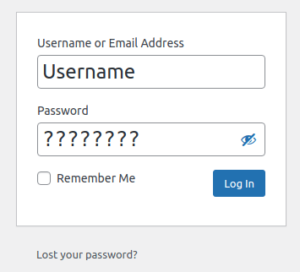
Proactive interference is when older information interferes with your ability to remember something newer. For example, you’re trying to remember the new login password you set but you keep thinking of your previous one.
Retroactive interference
Retroactive interference is the reverse of proactive interference: It’s when newer information gets disrupted by older information. For example, you’re trying to remember your home address from 10 years ago but you keep thinking of your home address from 2 years ago.
AO3 evaluation points: Forgetting due to interference
- Limited explanatory power: Interference only explains forgetting in cases where two types of information are similar, e.g. the address and password examples above. But much of what we forget (e.g. an event that happened in the past) seemingly cannot be explained as a result of interference.
- Questions of ecological/external validity: Psychological research on forgetting due to interference is often based on experiments in artificial (laboratory) settings and so the findings might not transfer to real-life situations.
Absence of cues
The second explanation of forgetting is an absence of cues. This happens when information is stored in long-term memory but can’t be accessed because there is nothing to trigger the memory. Tulving and Thomson (1973) suggest that forgetting is more likely to occur when the context in which the memory is recalled is different from the context in which the memory was coded.
Context-dependent failure
Context-dependent failure is when the external environment does not provide the cues necessary to recall a memory. For example, you might be perfectly able to remember your bank card pin code when you have to type it in an ATM, but struggle to remember it when walking along a beach.
State-dependent failure
State-dependent failure is when the internal environment during recall is different from the internal environment when the memory was coded.
 An example of a differing internal environment would be being sober vs. on drugs. For example, Darley et al (1973) observed that participants who forgot where they hid money while high on cannabis were more likely to remember where they hid that money once they got high again compared to when they were sober.
An example of a differing internal environment would be being sober vs. on drugs. For example, Darley et al (1973) observed that participants who forgot where they hid money while high on cannabis were more likely to remember where they hid that money once they got high again compared to when they were sober.
AO3 evaluation points: Forgetting due to absence of cues
- Evidence supporting forgetting due to absence of cues: The Darley et al (1973) study above supports the explanation that state-dependent failure can occur when an individual’s internal environment is different to the event they are trying to recall. Similarly, there are studies supporting the existence of context-dependent failure (i.e. forgetting when the external environment is different). For example, Godden and Baddeley (1975) got divers to learn lists of words on both dry land and underwater. They found the divers’ recall was much better in the environment it was learned (i.e. the words learned underwater were recalled better underwater and vice versa).
- Questions of ecological/external validity: Psychological research on forgetting due to absence of cues is often based on experiments in artificial (laboratory) settings and so the findings might not transfer to ordinary examples of forgetting.
Eyewitness testimony
Eyewitness testimony is where a person who was present at an event recalls what happened. It’s often used as evidence in court, but eyewitness testimony can be unreliable. So, psychological research into the factors affecting eyewitness testimony and how it can be improved is important to help ensure fair and accurate trials.
Factors affecting the accuracy of eyewitness testimony
Misleading information
Several psychological studies have shown the accuracy of eyewitness testimony can be altered after the event by exposing the witness to misleading information during post-event discussion.
For example, Loftus and Palmer (1974) conducted a study to test the effect of leading questions. The procedure for one experiment was as follows:
- 45 participants were shown the same video clips of car crashes.
- After each clip, the participants were asked to recall and answer questions on the car crash.
- The participants had been divided into 5 groups: Each group was asked the same question – “How fast were the cars going when they X each other” – but with a different verb in place of X:
- Contacted
- Hit
- Bumped
- Collided
- Smashed
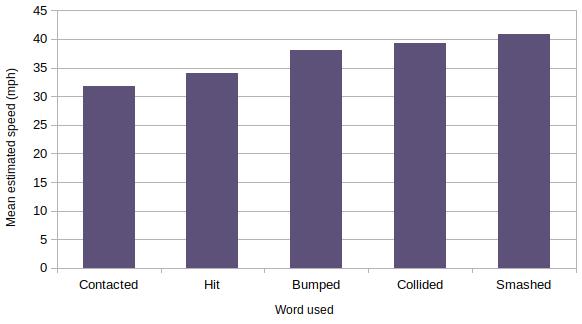
Asking the question using a more intense the verb (e.g. ‘smashed’) rather than a less intense verb (e.g. ‘contacted’), influenced the participant to estimate a higher speed. This supports the claim that asking leading questions affects eyewitness testimony.
In another study, Loftus (1975) found that leading questions can add false information to a memory. For example, in one experiment, participants were shown a video of a car journey and then asked “how fast was the car going when it passed the white barn?” despite there being no barn at all in the video. When asked to recall the event a week later, 17% of participants falsely remembered seeing a barn.
Anxiety
Another factor affecting eyewitness testimony is the witness’ anxiety levels. This is particularly relevant when witnesses are recalling anxiety-inducing events, such as violent crimes.
Deffenbacher (1983) suggested an ‘inverted-U’ hypothesis for the relationship between anxiety and the accuracy of eyewitness testimony. According to this hypothesis, a moderate amount of anxiety produces the most accurate and detailed eyewitness testimony. However, too much or too little anxiety reduces the accuracy of the eyewitness testimony.
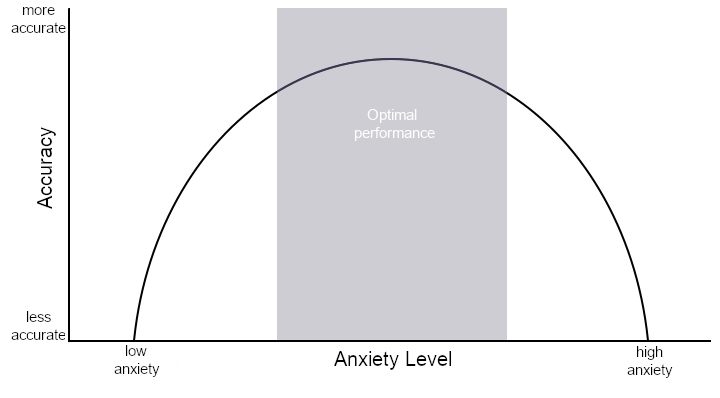
AO3 evaluation points: Inverted-U hypothesis
Research on the inverted-U hypothesis is somewhat conflicting. For example, in interviews with witnesses to bank robberies, Christianson and Hubinette (1993) found no relationship between anxiety and accuracy of testimony, weakening support for the inverted-U hypothesis.
However, several studies support the inverted-U hypothesis. For example, Loftus et al (1987) found that when an incident involves a weapon, witnesses will often focus on the weapon over all other details such as the perpetrator’s face, clothes, voice, etc. This ‘weapons effect’ supports the hypothesis that very high levels of anxiety reduce the accuracy and detail of eyewitness testimony. Further, a meta-analysis by Deffenbacher et al (2004) found high levels of stress negatively affect eyewitness testimony, further supporting the inverted-U hypothesis.
Improving the accuracy of eyewitness testimony
Psychologists have applied the kind of research above to develop methods for improving memory recall. An example of this is the cognitive interview.
The cognitive interview
The cognitive interview is a method of conducting police interviews to improve the accuracy and detail of eyewitness testimony. It draws on some of the research above, such as the need for cues to help trigger memory.
The elements of the cognitive interview are as follows:
| Context reinstatement | Recreating a mental picture of the event including both the external environment (e.g. the building, the weather, etc.) and the individual’s own internal state (e.g. how they felt at the time). Recalling the context in this way may provide cues that help trigger memories. |
| Recall from different perspective | Recreating the event from another person’s perspective (e.g. what another witness was seeing, or what the culprit saw) Considering the event from another perspective in this way may increase the accuracy of the testimony by reducing the effect of the witness’ schema. |
| Recall in different chronological order | Recreating the event in a different sequence in time (e.g. starting from the end and working backwards to the beginning) Recalling the event in a different order may also increase the accuracy of the testimony by reducing the effect of the witness’ schema. |
| Report everything | The witness is encouraged to report all details of the event even if they may seem irrelevant or unimportant. Because memories often have many different retrieval paths, recalling other details may provide cues that help trigger further memories. |
AO3 evaluation points: The cognitive interview
- Evidence supporting the effectiveness of the cognitive interview: Geiselman et al (1985) found that the cognitive interview increased the accuracy and detail of recollection compared to standard police interviews.
- Conflicting evidence: However, a meta-analysis by Kohnken et al (1999) found that although the cognitive interview increased the number of accurate details recalled compared to standard police interviews, the cognitive interview also increased the number of inaccurate details recalled.
- Importance of different factors: Milne and Bull (2002) found that some features of the cognitive interview are more important than others. In particular, context reinstatement and reporting everything appear to be the most crucial factors for an accurate and detailed eyewitness testimony.
- Fisher and Geiselman (1987) proposed the enhanced cognitive interview as a way to improve the accuracy of eyewitness testimony further. It adds several features to the original cognitive interview, including:
- Asking open-ended questions and allowing the witness to control the direction of the conversation
- The interviewer does not interrupt the witness
- The witness is made as calm as possible and encouraged to speak slowly